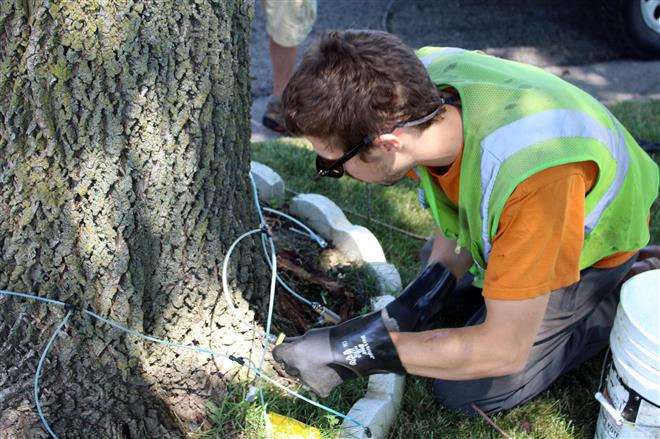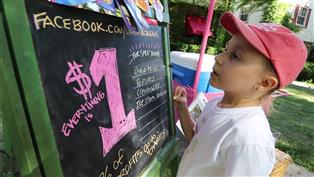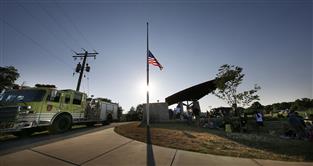Wauwatosa cruises through first year of emerald ash borer prevention
The project is funded by a $25,000 grant from the Department of Natural Resources
Four employees from the Parks & Forestry Department of Wauwatosa unloaded equipment from the bed of two trucks parked along Potter Road.
As they prepared to inject insecticide into the trunk of an Ash tree that belonged to the city in early August, their movements were like clockwork — almost as if they'd done it a thousand times before. Which they had.
To date, the Parks & Forestry Department has treated more than 1,600 Ash trees in Wauwatosa for the emerald ash borer, a pesty species that can be devastating to ash trees. The insect has an long, emerald-green body and was first discovered in North America in 2002.
So far, the department has found only one city tree affected by the emerald ash borers, and thanks to a $25,000 urban forestry grant from the Department of Natural Resources to treat city ash trees with preventive insecticide, the plan is to keep it that way. Wauwatosa hired a handful of forestry interns under the direction of a city arborist to treat approximately 4,000 city ash trees over the next two years, with much of the work being completed this summer.
"(Emerald ash borers) haven't been found heavily in our city yet," said the arborist, Stewart Korte. He added when the insect does hit, it could "eliminate" every ash tree in the city.
The plan is to only treat trees between 5 and 24 inches in diameter, said Korte. Older trees are likely larger, rendering them too expensive to treat for a life span that would come to an end soon anyway, he said. Emerald ash borers eat away at the tissue of the tree and can kill a large tree within a year, he said.
The city also is not treating privately owned ash trees, Korte said.
The arborist pointed to an ash tree on Potter Road, a stretch where the department was treating just two trees that day.
"This tree is healthy," he said, adding if emerald ash borers were inside the tree, there would be visible holes on the outside of the bark. If the bark was peeled away, there would be a noticeable zigzag pattern where the insect had burrowed, Korte said.
The team of four measured the circumference of the tree on Potter Road in preparation for injecting it with insecticide; the circumference directly correlates to how much insecticide is needed. When measuring the insecticide, precision is key, as a bottle of the insecticide costs upward of $400.
Holes were drilled near the base of the tree's trunk and then plugged with small spigots. Insecticide was pumped into the tree and in a matter of five minutes, the process was over. Forestry intern Ryan Kais estimated the cost of treating that one tree on Potter Road was about $70 worth of insecticide.
On a typical day, the team can treat about 50 ash trees, Kais said.
For those who desire a tree similar to the ash tree but could do without insect problems, Korte said, maples are a better option.

E-mail Newsletter
Your link to the biggest stories in the suburbs delivered Thursday mornings.
Enter your e-mail address above and click "Sign Up Now!" to begin receiving your e-mail newsletter
Get the Newsletter!
More from News and Features
- Anodyne Coffee plans to open location in Wauwatosa Village
- Wauwatosa Meetings: Aug. 4
- Video: Wauwatosa girl's curbside ice cream stand raises money for the hungry
- Wauwatosa News and Notes: Hands-only CPR training offered; Firefly Art Fair is Aug. 6-7
- Wauwatosa Ask Now: Why are there barriers and fencing along the North Avenue bridges over the Menomonee River?
- Mystery Photo Contest: July 28
- Wauwatosa gears up for National Night Out event, this year at the zoo
- Election 2016: Wisconsin's 4th District candidates weigh in
- Wauwatosa's Luther Manor residents share smiles through flower delivery
- Wauwatosa Police Report: July 17-23















We welcome reader discussion but strive to keep things civil. Please see our discussion guidelines and terms of use for more information. If you see a comment that violates our guidelines, please flag it for review. If you have any other issues with our commenting system, please let us know.